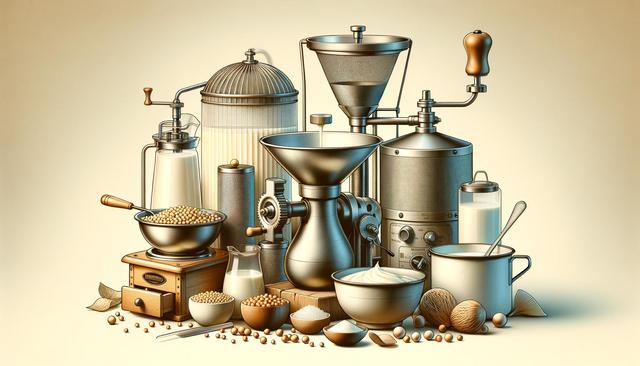Cleaning and Sorting Equipment
The first step in soymilk production is ensuring that the raw soybeans are clean and free from impurities. Cleaning and sorting equipment plays a vital role in achieving this. Typically, this stage involves the use of machines such as vibrating screen separators, gravity destoners, and magnetic separators. These tools help remove dust, stones, metal fragments, and other foreign materials that may compromise product quality or damage downstream equipment.
Some commonly used cleaning tools include:
- Vibrating sieves – to separate particles based on size
- Destoners – to eliminate heavier contaminants like stones
- Magnetic separators – to extract ferrous materials
Effective cleaning ensures that only high-quality soybeans proceed to the next stage, laying the groundwork for producing a safe and consistent soymilk product. This equipment is essential not only for quality assurance but also for maintaining hygiene standards in food processing.
Soaking and Dehulling Equipment
Once cleaned, soybeans must be soaked to soften them for grinding. Soaking equipment often consists of stainless steel tanks equipped with water inlets, temperature control systems, and drainage mechanisms. The soaking time and water temperature are critical parameters that affect the final texture and flavor of the soymilk.
After soaking, dehulling machines are used to remove the outer skins of the soybeans. This step is important because hulls can affect the taste and reduce the smoothness of the final product. Dehulling can be done manually on a small scale, but in commercial settings, mechanical dehullers significantly improve efficiency and consistency.
Key functions of soaking and dehulling equipment include:
- Softening beans to prepare for grinding
- Improving nutrient extraction during milling
- Enhancing the texture and color of the final product
Proper soaking and dehulling contribute to higher yield and superior quality, making this stage critical in soymilk processing.
Grinding and Slurry Production
Grinding is a pivotal stage where soaked soybeans are transformed into a fine slurry. This is typically achieved using high-speed grinders or colloid mills that crush the beans in the presence of water. The resulting slurry contains all the soluble proteins, oils, and other components necessary for soymilk production.
Advanced grinding equipment offers adjustable settings to control particle size, which is crucial for achieving a smooth and creamy texture. Some systems also incorporate cooling features to prevent overheating, preserving the nutritional integrity of the soybeans.
Features of efficient grinding equipment include:
- High-speed blades or burrs for uniform consistency
- Water injection systems for controlled mixing
- Easy-to-clean surfaces to maintain hygiene
Proper grinding ensures that the maximum amount of nutrients are extracted from the soybeans, which enhances both the flavor and nutritional profile of the resulting soymilk.
Heating and Cooking Systems
Heating the soybean slurry is necessary to deactivate enzymes and eliminate any beany flavor. This is typically done in large steam-jacketed kettles or batch cookers. The cooking process also helps to denature proteins, which aids in their digestibility and improves the stability of the soymilk.
Some modern soymilk production lines use continuous cooking systems that integrate seamlessly with other stages for higher throughput and consistency. Temperature control is crucial here, as overcooking can affect taste and undercooking may compromise safety and shelf life.
Common heating and cooking tools include:
- Steam-jacketed kettles – ideal for batch processing
- Continuous cookers – for automated, large-scale production
- Temperature sensors – to maintain precise cooking conditions
The heating stage not only ensures food safety by eliminating harmful microorganisms but also enhances the sensory qualities of the final beverage.
Filtering and Finishing Equipment
The final steps in soymilk production involve filtering the cooked slurry to separate the liquid from the okara, which is the soybean pulp by-product. This is often done using fine mesh filters, centrifugal separators, or decanter centrifuges. The goal is to produce a smooth, grit-free liquid that meets consumer expectations for mouthfeel and clarity.
After filtration, the soymilk may undergo homogenization and pasteurization. Homogenizers break down fat molecules to ensure an even distribution, while pasteurizers heat the liquid to eliminate any residual bacteria. These finishing processes are essential for extending shelf life and maintaining product consistency.
Equipment used in this stage includes:
- Fine mesh strainers or cloth filters – to remove solids
- Centrifugal separators – for rapid and efficient separation
- Homogenizers and pasteurizers – to finalize the product
Each piece of equipment used in filtering and finishing plays a role in ensuring that the soymilk is not only safe to consume but also enjoyable in taste and texture.
Conclusion
Producing high-quality soymilk requires a well-coordinated series of processes, each supported by specialized equipment designed for specific functions. From cleaning and soaking to grinding, heating, and filtering, every stage demands precision to ensure the final product is both nutritious and appealing. For food processors, understanding and investing in the right equipment is essential for operational efficiency, product consistency, and consumer satisfaction.




Leave a Reply